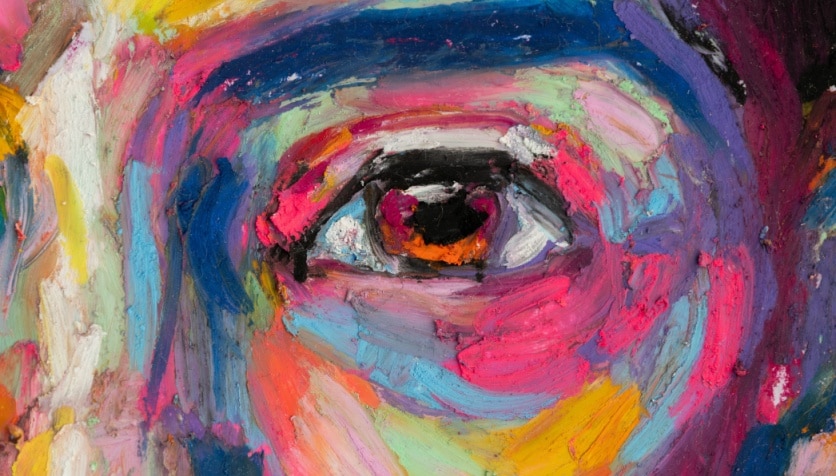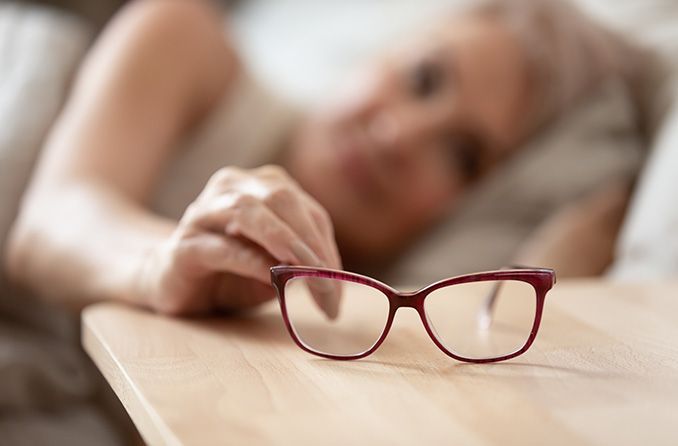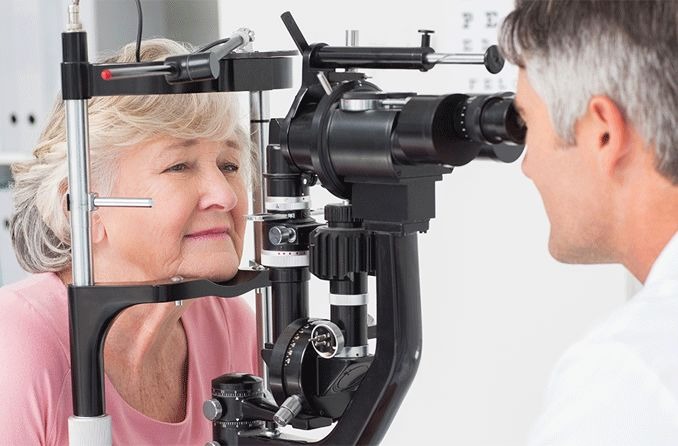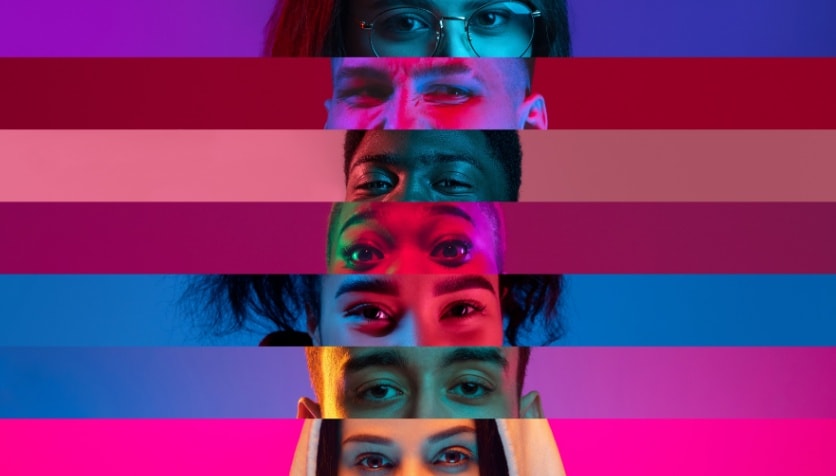A-B | C-D | E-H | I-L | M-O | P | Q-S | T-Z
reading glasses Also called readers. Glasses to help with close work, particularly for people who are presbyopic. More about reading glasses.
refraction The test performed during an eye exam to determine the eyeglass lens powers needed for optimum visual acuity. An automated refraction uses an instrument that does not require the patient to respond. A manifest refraction is the manual way to determine the best lenses, by placing various lenses in front of the patient's eyes and asking, "Which is better, lens A or lens B?"
refractive error Any of a number of size- and shape-related abnormalities of the eyeball (or components of the eye) that affect the normal ability of the eye to focus light on the retina. Learn more about refractive errors.
refractive surgery Surgery that corrects visual acuity, with the objective of reducing or eliminating the need for glasses and contacts. Includes radial keratotomy, PRK, LASIK, and corneal implants.
replacement schedule How often you discard and replace your contact lenses: every day, week or two weeks (disposable); or every month, two months or calendar quarter (frequent replacement). It's important to differentiate between replacement schedule and wear schedule. Wear schedule is either daily wear (removed before sleeping) or extended wear (you may sleep with them in).
retina The sensory membrane that lines the back of the eye. Cells in the retina called photoreceptors transform light energy into electrical signals that are transmitted to the brain by way of the optic nerve. Learn more about the retina.
retinal detachment Condition where the retina separates from the choroid. Retinal detachments have many causes, including aging, surgery, trauma, inflammation, high myopia and diseases such as diabetic retinopathy, retinopathy of prematurity and scleritis. Symptoms include light flashes, floaters, a shadow coming down over your vision, blurred vision and vision loss. For more information, please see our retinal detachment article.
retinal pigment epithelium (RPE) A layer of pigmented cells found between the light-sensitive, inner back lining of the eye (retina) and the choroid, which contains blood vessels that supply nutrients and oxygen.
retinal tear A tear or split in the retina typically caused by a vitreous detachment. Symptoms include floaters and light flashes.
retinitis Inflammation of the retina. Symptoms include blurred vision, metamorphopsia, floaters and vision loss.
retinitis pigmentosa Usually inherited condition characterized by progressive degeneration of the retina, resulting in night blindness and decreased peripheral vision. For more information, please see our retinitis pigmentosa article.
retinopathy of prematurity An eye disease common in premature babies that involves abnormal growth of blood vessels in the inner back of the eye (retina). Also known as ROP.
retinoschisis Condition in which the retina splits into layers, sometimes causing blurred vision. It is either inherited or acquired; the acquired form is caused by small cysts in the eye. You may also have floaters. For more information, please see our retinoschisis article.
retrobulbar hemorrhage Bleeding in the eye socket behind the eye. If untreated, can cause increased intraocular pressure (IOP), protrusion of the eyeball and permanent vision loss.
rewetting drops Eye drops designed to re-moisten and lubricate contact lenses while they are being worn, to increase comfort.
RGP (Rigid Gas Permeable) Type of contact lens made of breathable plastic that is custom-fit to the shape of the cornea. RGPs are the successor to old-fashioned hard lenses, which are now virtually obsolete.
rhegmatogenous Arising from a break or tear, describing a common type of retinal detachment.
rheopheresis The RHEO Procedure ("rheopheresis") is a method of blood filtration (apheresis) or treatment of dry age-related macular degeneration that removes large proteins and fatty components from the blood to improve circulation to macular cells at the back of the eye. For more information, please see our article on age-related macular degeneration.
rheumatoid arthritis Chronic, autoimmune, inflammatory disorder that mainly affects the joints. Symptoms include pain, stiffness, swelling and deformities. Rheumatoid arthritis may also cause eye burning, discharge and dryness. It can be associated with uveitis.
river blindness Onchocerciasis is caused by a parasitic worm, which is spread in the human bloodstream through bites from blackflies and buffalo gnats found in parts of Africa, South America, and Central America. The worm's offspring cause inflammation, bleeding, and other problems in the eye. Without a 15-year regimen of annual doses of Mectizan, blindness will result. (Information supplied by ORBIS International.)
RK (radial keratotomy) Surgical procedure where cuts are made in the cornea in a radial pattern, to flatten the cornea and correct myopia. However, RK now is virtually obsolete as a corrective eye procedure.
rod A photosensitive receptor in the retina that helps you to see in low light.
rosacea Skin condition typically involving the face that is characterized by flushing, red bumps and telangiectasia (dilated, visible capillaries); it is most common among fair-skinned women, who develop it in their 30s through 50s. Please click here for information on ocular rosacea.
sarcoidosis Disease in which granulomas (nodules of inflamed tissue) form in the lymph nodes, lungs, skin and other areas. The cause is unknown. Symptoms include fatigue, weight loss, fever, coughing, uveitis, cranial nerve palsies and skin lesions. Some patients also develop dry eyes.
Schlemm's canal A porous channel within the eye through which fluids drain. When drainage is blocked, high eye pressure can cause eye damage related to glaucoma.
sclera The outer coat of the eyeball that forms the visible white of the eye and surrounds the optic nerve at the back of the eyeball.
scleritis Inflammation of the sclera. Autoimmune disorders are the most common cause. Symptoms include a red or pink eye, eye pain, light sensitivity, tearing and blurred vision.
scotoma Blind spot within the field of view. Please click here for information on scotomas.
seborrheic dermatitis Skin condition that causes scales, redness and itching; it commonly affects the scalp (dandruff), eyebrows, eyelids, nose, area behind the ears and sternum. It is associated with seborrheic blepharitis.
segment A part, as in the near-vision portion of a pair of bifocals.
silicone Type of flexible and comfortable plastic. Because it is commonly used in nose pads in eyeglasses, people who are allergic to silicone should ask their eye doctor for a different type of nose pad.
single vision A lens that has the same power throughout the entire lens, in contrast to a bifocal or multifocal lens that has more than one lens power.
sinusitis Inflammation of the sinuses, due to an infection or an allergic reaction. Probably the most common cause of pain in and around the eye. Symptoms include head pain (headache, pain around the eyes, toothache, jaw pain), nasal discharge, postnasal drip, coughing, eyelid swelling, swelling around the eyes, a stuffy nose, fatigue, bad breath and a sore throat.
Sjogren's syndrome An inflammatory autoimmune disorder characterized by a dry mouth and dry eyes. Additional eye symptoms include burning, discharge, foreign body sensation, itching and light sensitivity. Read our article on Sjogren's syndrome.
skin cancer Skin cancer is commonly caused by exposure to the sun's UV rays. Types include basal-cell carcinoma, squamous cell carcinoma and malignant melanoma. In carcinoma, you will likely have a red or pink bump that bleeds, crusts and scales. In melanoma, the pigmented areas can be raised or flat; they are often brown or black, but can be (or include) other colors as well, such as blue, red, pink or white. Some raised moles are skin-colored. The most common symptoms of a malignant mole follow an ABCD checklist:
- Asymmetry: one half does not match the other.
- Border: irregular or scalloped.
- Color: varies in shade or color.
- Diameter: larger than that of a pencil eraser.
Snellen chart Standard chart with letters, numbers, or symbols printed in rows of decreasing size used by eye care professionals in distance visual acuity testing. The chart was invented by Dutch ophthalmologist Hermann Snellen. Read an article about eye test charts.
soft contact lenses Contacts made of gel-like plastic containing varying amounts of water.
solution Product used to clean, disinfect and store contact lenses.
spatial frequency In optics and other fields, a measure of how often a repeating structure (such as a vertical line or bar) appears within a given unit of distance.
SPF (sun protection factor) Number representing the amount of sun something blocks. For example, if you normally begin to burn after half an hour in the sun, a sunscreen with an SPF of 2 should let you stay out twice as long (one hour), SPF 4 should let you stay out four times as long, and so on.
spherical A contact lens design that is like a sphere and is fairly common; in contrast, toric lenses for astigmatism are oval-shaped and are less common.
spherical aberration A common higher-order aberration of lenses or the eye that causes glare and halos around lights at night.
spots Small, cloudy specks in the eye that become noticeable when they fall in the line of sight. Read our spots and eye floaters article.
spring hinge Type of hinge on eyeglass frames that is more flexible than a regular hinge, making the frames more durable.
stereopsis Three-dimensional vision, enabling depth perception.
strabismus A misalignment of the eyes: the eye don't point at the same object together. Crossed eyes (esotropia) are one type of strabismus; "wall-eyes" (exotropia) are another. The exact cause is unknown, but appears to be a problem with the eye muscles. Strabismus can affect depth perception. Read our article on strabismus.
stroke An interruption in blood flow to the brain, resulting in tissue death. Blood clots and other obstructions can interrupt the blood flow, as can a ruptured artery. Symptoms include weakness or numbness, particularly on one side of the body, a change in consciousness or mental status, vision loss, double vision, and limited eye movement. You may also blink frequently. Also read our article on eye strokes.
stroma The cornea's middle layer; it consists of lamellae (collagen) and cells, and makes up most of the cornea.
sty Also spelled "stye." A small red bump on the edge of the eyelid caused by an infected gland. Additional symptoms include eyelid pain, eyelid swelling, eye pain or discomfort, foreign body sensation, light sensitivity and tearing. Read our article about styes.
subconjunctival hemorrhage Bleeding from blood vessels on the surface of the eye that leaves a red patch. This common problem can be caused by sneezing, coughing, high blood pressure, trauma and more. Read more about blood on the eye.
superior limbic keratoconjunctivitis A condition characterized by episodes of recurrent inflammation of the superior cornea, the junction between the cornea and the sclera (the limbus), and the conjunctiva lining the superior sclera and inner surface of the upper eyelid.
surgery complication Complications from cataract surgery, LASIK or other eye surgeries can result in a variety of symptoms, including blurred vision, ptosis, foreign body sensation, halos around lights, light sensitivity, eye pain or discomfort, red or pink eyes, vision loss and an iris defect.
suspensory ligament Also called zonule of Zinn. Membrane of fibers (zonules) that holds the eye's lens in place.











